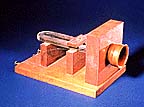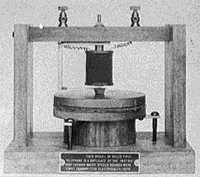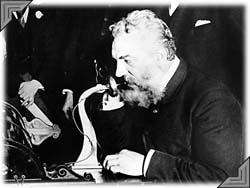
|
|
|
Alexander Graham Bell was born in 1847 in Edinburgh, Scotland. His own mother was deaf, and he had a background of learning about sound and was a teacher for the deaf. He used Visible Speech to help him teach the children how to speak. Visible Speech, which his father had invented to help his wife, consists of pictures of a mouth moving in different ways. Since the deaf can't hear what they're saying, they at least can know how their mouth is supposed to move when they're saying a word.

In 1875 Alexander Graham Bell moved to Boston and hired Thomas Watson to help him on the harmonic telegraph (the telephone). Watson was very skilled and helped Bell to develop his thinking. Watson worked on the transmitter day and night, and was very good at it. Bell worked on the receiver and every few days they would check it together.
Bell and Watson hoped to find an answer to their Key Question.

At this early point, Bell thought the instrument should be a series of reeds arranged over a long magnet. As each reed responded to the voice, it would vibrate alternately toward and away from the magnet, creating the undulating current.

This "harp apparatus" (as Bell called it) was not the telephone. He did not yet realize that a single reed could convey all the elements of human speech. The breakthrough came one day in June, in 1875. Bell asked Thomas Watson to pluck a steel receiver reed with his finger to make sure it was not stuck. When Watson vibrated the reed, the receiver in Bell's room also vibrated, even though the current was turned off. Bell realized that the vibration had generated an undulating current, solely on the strength of a slight magnetic field. In that moment, the telephone was born.
When they finally made a successful telephone in 1875, Bell wanted to show it to the public. He brought it to the Philadelphia Centennial Exposition on Sunday, June 25, 1876. The Exhibition was organized to celebrate the 100th anniversary of the signing of the Declaration of Independence. Having entered at the last moment, Bell found there was no room in the electrical section. Instead, he had to set up far away, in a corner of the educational exhibit.
 ...................................
...................................
It was a hot day and the judges did not like the long trip down the corridor and up a flight of stairs. Their fatigue vanished with the first words that came crackling over the telephone wire. Pandemonium broke out as these distinguished scientists raced to see if Bell's voice in another room had indeed produced the sounds. The telephone became the star attraction. Above you can see his sketch of the phone, and the phone he built.
Bell himself had no doubts about the importance of his new discovery. Shortly after the telephone's invention, he had written to his father,
"The day is coming when telegraph wires will be laid on to houses just like water or gas -- and friends will converse with each other without leaving home."
|
|
1) When Bell spoke into the tube, the membrane vibrated. 2) This caused the needle to bob up and down in the liquid. 3) When the needle moved closer to the bottom of the cup, there was less resistance in the circuit, and the current grew stronger. When the needle moved away from the cup, resistance increased, and the current grew weaker. 4) The telephone receiver, made up of an electromagnet and a metal plate, imitated sounds according to the fluctuating current. The electromagnet grew stronger and weaker with the changing current, pushing and pulling the metal plate. The metal plate vibrated, thereby imitating speech sounds. The receiver converted the electrical impulses back into audible sound so that words could be heard. |
The first spoken phone message
The telephone patent was one of the most valuable ever issued. Bell received it on March 7, 1876, four days after his 29th birthday. Speech, however, had not yet been transmitted. That would occur five days later, on March 12, when Watson heard the famous words, "Mr. Watson -- Come here -- I want to see you."

Alexander Graham Bell is most known for the telephone. Bell's willingness to search out the path less taken resulted in some of the world's most important inventions. It has been said that Bell invented the telephone by searching for it in places where other inventors would never think to look. Bell's ability to believe in the impossible has served the world well. He was a man ahead of his time. Even today, he inspires students to look outside the box for answers to questions that have not yet been asked.
.